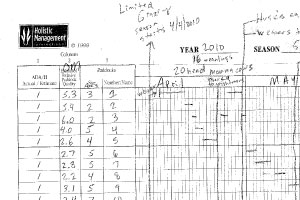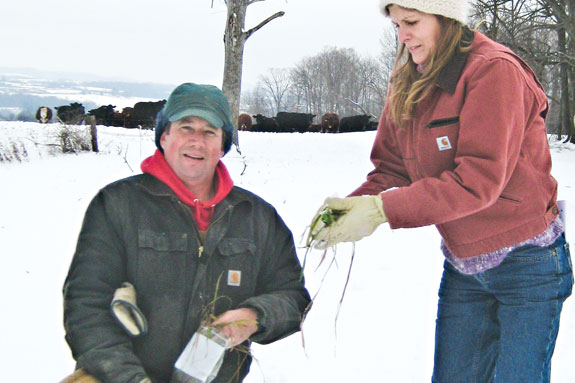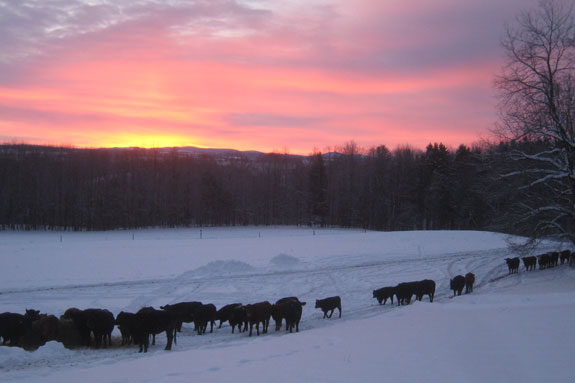Opportunity, however, is only as good as what you make of it. After 20 years of managing pastures with cattle, I have come to realize I’m still learning the nuances of this holistic system.
Since 1877, my family has been farming in the Mohawk Valley of central New York, on a hundred acres of high-lime soils with abundant water and a climate made for grass production. It has taken me a lifetime to realize that I’m a grass farmer with cattle, not a cattleman with grass.
In fact, ruminant animals are merely tools to harvest the sun’s free energy and provide the synergy that activates the soil fungi, improves the water and mineral cycle, and provides sustenance for a community.I learned early on that grazing management takes flexibility and a certain amount of independent, critical thinking. I have used continuous grazing, short “golf course” rotational grazing, controlled grazing, short-duration grazing, prescribed grazing and intensive grazing management, to name a few.
These systems have helped me shape my landscape to a point, but I have found they favor the animal more than the land, and for me that is not profitable. What we want is to mimic a prairie ecosystem, right here in upstate New York.
With the help of Jim Gerrish, Phillip Metzger, Greg Judy, Jerry Brunetti and Kit Pharo, among others, I am now beginning to grasp that the key to profitable grazing is creating a family goal in concert with a heavily-monitored pasture plan and chart, and to have your animals birth in sync with Mother Nature.
Our goal is to have diverse pastures with deep roots as the driver. We achieve this by adopting the mantra, “We will graze no plant before its time.” This thought process allows us to graze for 265 days and, more importantly, to only feed hay for 100 days.
Our 2010 grazing season really started in 2009, when we determined what fields (according to our nutrient management plan) to winter on. It was planned then to lay these fields fallow for rejuvenating the stand, maximizing native seed production and incubating young birds and other wildlife, while saving this sward for midsummer grazing.
We feed on a pad in mud season and have, over time, let the grass get 4 inches on it before we run the cows through the 20 paddocks to snip the bunchgrasses in order to stimulate plant tillering. One bite is it!
This year we started grazing on April 4, a full three weeks early. The reason – stockpiling last fall gave us a full root system to start the season with.

The beauty of cows calving in late spring is they get all this high-quality grass to fully flesh up and so are slick and healthy when they calve. This year they birthed an unassisted 100 percent calf crop.
Since it is cheaper to buy hay than to make it, we employ a herd of custom-grazed grass-finishers to eat the excess growth, and since they are marketed every month, we have declining numbers going into late summer for stockpiling. I’ll admit, it’s nice to have these part-timers.
[Click the image at right to open a pdf of Bishopp's grazing plan.]
Since I try and plan for well-rested roots, our swards tend to be on the taller side, sometimes to prairie height. To my neighbors, it looks a little unruly at times and, in the conventional sense, mismanaged.
My rest periods have ranged from 34 days up to 103 days, with an average of 55 days. This strategy allows for a myriad of plant species, heights, root depths and nutrient diversity.
I can hear you say, “No cattle can thrive in this rank environment.” I thought so too, but I am learning just the opposite. I have taken the approach of letting them graze in a high-density fashion and watching them choose to eat sun-drenched seed heads first, followed by leaves, and ending at the bottom buried in legumes.
The rest is trampled as litter for the soil fauna. Upon doing some biological monitoring of the fields, they are vibrant with soil life and young shoots, just the way Mother Nature intended.
Our number one expense is purchased feed, so on August 10 we start stockpiling to graze into late fall and winter. We do not wean the calves, since this forage has tested better than alfalfa hay, and we want the cows to teach their calves to graze through the snow.
I’m most excited about stockpiled forage and crop residue because it cuts the daily feed bill in half, $0.46 per head per day versus $1 per head per day, and it completely rests the roots while providing good feed and a walking manure spreader. My only limitation to grazing longer is that I need more of it.
I am investigating moving all the cows off to another farm and stockpiling the entire farm. If this proves successful, I may be able to get my annual cow/calf cost below $200 in the land of high taxes.

I watched the bison graze in Yellowstone on TV and thought, “They don’t have any hay feeders or tractors and still they survive.” As I thought about it more, it occurred to me that the massive herds of bison might have grazed over this farm at one point.
Are we coming full circle in grazing planning for the ages? History does have a funny way of repeating itself. I would be pleased if my real-life experiences and legacy of learning would mimic this perfect prairie system.
After all, the foundation of our country came from this diverse ecosystem. I think it’s time to seize the opportunity. FG
Troy Bishopp posts regularly on his blog at www.thegrasswhisperer.com
PHOTOS:
PHOTO 1: By planning ahead, cows can graze in pastures, even during the winter months. Photo courtesy of Troy Bishopp.
PHOTO 2: Throughout the year, Troy schedules his grazing rotation to make the best use of the resources available on his farm. Figure courtesy of Troy Bishopp.
PHOTO 3: Sampling forage helps the Bishopps understand more about the available feed for their animals. Photo courtesy of Troy Bishopp.









